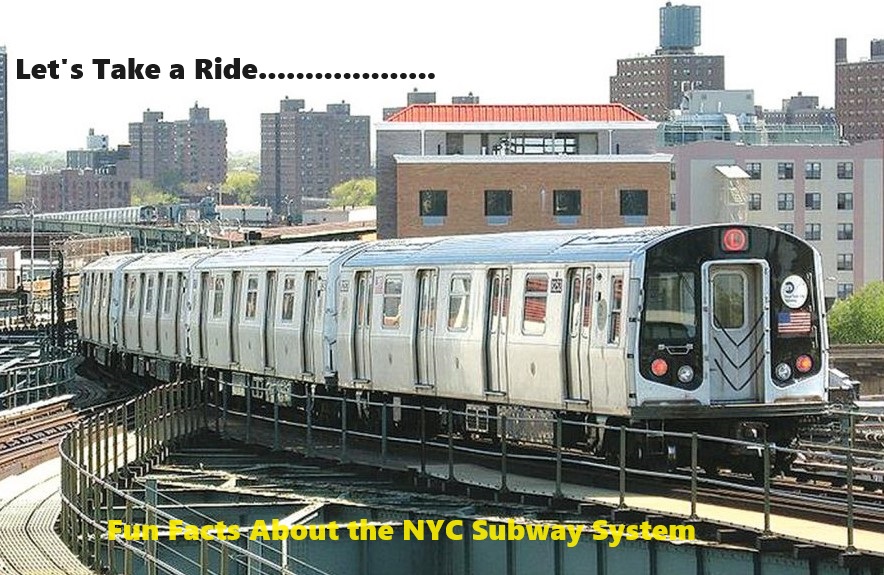This week we’re going to go for a fun ride via the New York City Subway system, one of the largest in the world. When people come to the Big Apple for a vacation, three things are a must. Seeing a Broadway show, a trip up to the observation deck of the Empire State Building and taking a ride on the subway.
Well obviously, we can’t take you on a real ride, like I did hundreds of times before moving to Florida. So, I want to give you some fun facts about this incredible feat of engineering genius that has stood the test of time.
********************
The first New York City subway began in October 1904 and the cost to ride it was just a nickel. Fact is as the subway system grew that nickel ride stayed in place until 1948 when it was raised to ten cents. Today it is $2.75.
The very first New York subway line was known as the IRT (Interborough Rapid Transit). It ran from City Hall to Harlem, covering 9.1 miles and 23 stations.
Today the entire NYC subway various routes encompass 661 miles and 472 stations. Surprisingly, just 60% of the subway system is underground. The other 40% is either elevated or run at ground level.
You can add another 186 miles of track that cover all the New York City Transit’s yards, shops and storage areas for all the trains, maintenance, etc. bringing the grand total to 847 miles of track.
There are 279 underground subway stations and 153 elevated stations, plus 31 embankment stations (outdoors, ground level) and 9 open-cut stations (built below street level, in a trench-like depression but exposed to the outdoors.)
Throughout the entire system the NYC subways will pass over 68 different bridges and through 14 different underwater tunnels.
How far could you go if all the track in the system were laid end to end? You could go from New York City to Chicago.
While the majority of routes the subways use to cover all the boroughs are of various lengths in miles, the longest route is the “A” train. It runs from 207th St. in Manhattan out to Far Rockaway in Queens, a distance of 31 miles.
Having a platform 173 feet below street level, the 191st Street station is the deepest subway stop. Its counterpart is Smith and 9th streets stations, being the highest stations at 88 feet above street level.
The busiest station on the entire system is the 42nd St./Times Square station. Over 65 million people a year come through the station to get to the various lines. Speaking of ridership.
Having a 1.7 billion ridership yearly, the New York City subway is certainly busy. It is the busiest system in the United States, but only ranks seventh in the world. Tokyo is #1 doubling NYC subway’s total number of riders annually at 14 billion.
The rolling stock for the NYC subway system consists of 6,814 cars, but that will increase as more new stock will be added bringing the total to 7,000 plus cars. Each car in the system is either 51.8 feet long or 60.6 feet long.
Every subway train is made up of ten cars and they are rarely empty regardless of the time of day. Because of that, every single subway station underground or above ground is 600 – 640 feet in length to accommodate the entire train.
There are nine ghost stations in the NYC subway system: The most beautiful is the abandoned City Hall station that was in service from day one in 1904 up until 1945. Today, a yearly event to celebrate it’s opening takes place at this station.
To get around New York and the boroughs there are 36 different lines available through the IND, BMT and IRT subways. All of the routes for the IND and BMT are signified by letters, A, B, C, D, etc. The IRT lines use numbers.
When graffiti became the big thing in 1970’s, the NYC subway cars became an instant target. In 1981 all of the cars were painted white to make them look cleaner, but the graffiti artists ruined that idea very quickly.
Many action movies set in New York City were filmed or have featured the NYC subway. Some of these flicks include “The Taking of Pelham One Two Three” (1974), “Money Train” (1995), and “Die Hard with a Vengeance” (1995).
There is so much more I could add about this incredible feat of engineering that has stood the test of time. But I urge those who have never ridden a New York subway to take a virtual trip via a “Front Window” view just to see what it’s like above and below ground. Here is a very good link with a number of front view options to choose from (I have taken about seven or eight thus far)….. https://www.bing.com/videos/search?q=Front+View+Subway+Window+Rides&FORM=VRPATC you will have many to choose from. You will be fascinated just as I was a young child and still am today as an adult with a love for trains of all kinds.
Art Koch, National Features & DVD Editor, NightMoves Magazine and AAN
























No comments